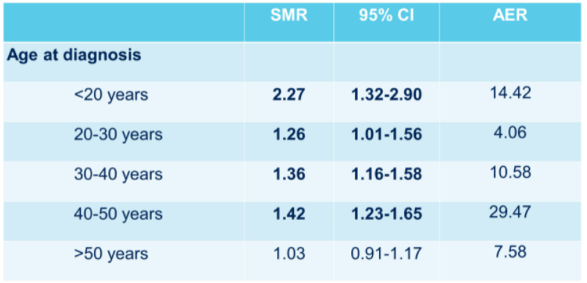
To do this study, the authors utilized the cancer registry of Norway, which included over 5700 men diagnosed with testicular cancer between 1980 and 2009, and linked treatment details for patients with the Norwegian Cause of Death Registry. The total cohort and patients within the cohort who were found to have a cause of death not related directly to testicular cancer are described below. More than half of patients in each group received three or four cycles of cisplatin-based chemotherapy.

Standardized mortality ratios (SMR) were increased in patients who received either platinum-based chemotherapy, radiotherapy, or both relative to surgery alone.

This is also reflected in the curve below of proportion of non-testicular cancer mortality over time.

The overall elevated SMR associated with second cancers in patients that received platinum-based chemotherapy was associated with lip/oral cavity/pharynx cancers, bladder cancer, esophageal cancer, leukemia (SMR 3.26) and lung cancer. The overall elevated SMR in patients who received radiotherapy was associated with bladder, pancreas, lip/oral cavity/pharynx, stomach, and liver cancers. With regards to non-cancer-related causes of death, patients who received platinum-based chemotherapy had a higher mortality risk related to suicide (SMR 1.68 95% CI 1.01-2.69) but not cardiovascular disease (SMR 1.18 95% CI 0.87-1.60), whereas patients who received radiotherapy had higher mortality related to digestive diseases. The SMR as well as absolute excess risk (AER) of non-testicular cancer-related mortality in patients treated for testicular cancer began to rise after 10 years of follow-up and was highest in patients who were diagnosed at younger than 20 years of age.


Using a time-dependent Cox regression model, the authors determined that four or more cycles of platinum-based chemotherapy conferred an elevated hazard ratio for non-testicular cancer-related mortality (HR 1.47 95% CI 0.91-2.39 for three cycles, HR 1.47 95% CI 1.01-1.99 for four cycles, and 2.04 95% CI 1.25-3.35 for more than 4 cycles).
Dr. Hellesnes ended her presentation by concluding that in this Norwegian cohort, non-testicular cancer risk of death in testicular cancer survivors was highest in patients diagnosed at the youngest age, the risk of death increased with more cycles of cisplatin-based chemotherapy and was attributable to second cancers and increased risk of suicide. Attention to these factors for early intervention to limit the risk of premature death is essential.
Presented by: Ragnhild Hellesnes, Department of Oncology, University Hospital of North Norway, The Arctic University of Norway.
Written by: Alok Tewari, MD, PhD, Medical Oncologist at the Dana-Farber Cancer Institute, at the 2021 American Society of Clinical Oncology (ASCO) Annual Meeting, Virtual Annual Meeting #ASCO21, June, 4-8, 2021


